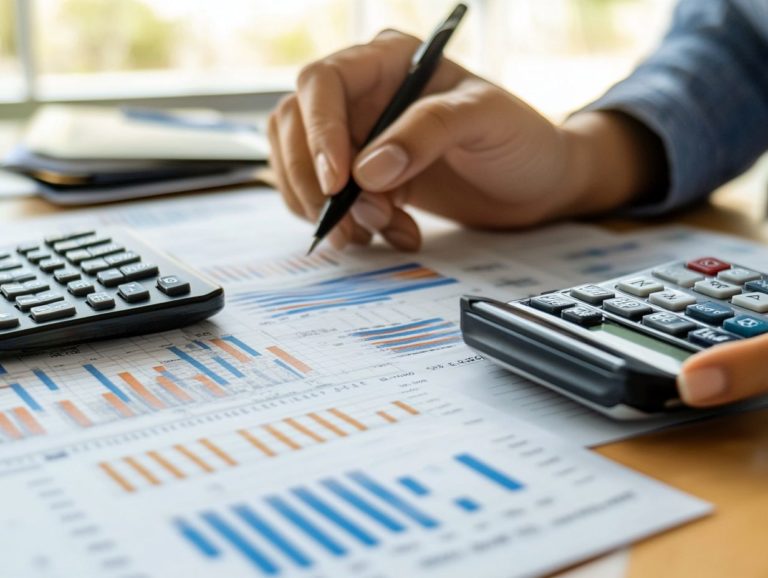What is the Impact of Inflation?
Inflation, particularly high inflation, is a vital economic concept that influences everyone’s life. Yet, its complexities often elude many.
This article clarifies what inflation is and why it matters, delving into its various effects on prices, purchasing power, employment, and wages. You ll also explore various methods for measuring this phenomenon.
The discussion will include government strategies for managing inflation and its impact on different socioeconomic groups, especially in the context of inflation in the United States.
Grasping these elements is essential for successfully navigating today s economic landscape.
Contents
- Key Takeaways:
- Understanding Inflation
- Effects of Inflation on the Economy
- Inflation’s Impact on Prices and Purchasing Power
- Effects on Employment and Wages
- Ways to Measure Inflation
- Common Methods and Indicators
- Managing and Controlling Inflation
- Inflation’s Impact on Different Groups
- Frequently Asked Questions
Key Takeaways:

- Inflation is a general increase in prices caused by factors such as excessive money supply or rising production costs.
- Inflation significantly impacts the economy, affecting prices, purchasing power, employment, and wages.
- Governments use various methods to measure and manage inflation, including controlling interest rates and adjusting taxes. Different groups in society experience inflation in varying degrees, with some being more vulnerable than others.
Understanding Inflation
Understanding inflation is essential for navigating the broader economic landscape, especially in the United States. Recent events like the COVID-19 pandemic and shifting consumer prices have greatly impacted the economy.
Inflation represents the overall rise in prices of goods and services, which can impede economic growth and erode your purchasing power. Recognizing the various causes, such as inflation caused by higher consumer demand and inflation stemming from rising production costs, is vital. Additionally, understanding the impact of inflation on budgeting and the different indicators used to measure inflation is also important.
This knowledge is crucial not just for you as a consumer but also for policymakers striving to make informed decisions.
Definition and Causes
Inflation represents the rate at which the general level of prices rises, gradually eroding your purchasing power and influencing economic growth. The primary drivers of inflation fall into two categories: inflation caused by higher consumer demand and inflation stemming from escalating production costs.
Understanding inflation is essential as it affects key economic indicators like interest rates and wage growth, ultimately shaping your everyday financial choices. For instance, inflation caused by higher consumer demand occurs when a surge in spending, often fueled by an optimistic economic outlook or government stimulus, pushes prices higher. Think about the holiday seasons when the demand for electronics spikes, prompting retailers to raise their prices significantly. To learn more about how this relates to your finances, consider exploring the impact of interest rates.
Conversely, inflation stemming from rising production costs happens when expenses for raw materials and labor increase, compelling businesses to pass those costs onto consumers. A recent example is the hike in oil prices, which impacts transportation costs and leads to increased prices for goods across various markets. Recognizing these distinctions empowers you to tackle your finances with confidence!
Effects of Inflation on the Economy
The effects of inflation on the economy are profound and multifaceted. They influence everything from consumer prices to the monetary policy decisions made by central banks in the United States and beyond.
High inflation erodes your purchasing power, diminishes savings, and complicates strategies for managing inflation. This situation creates a delicate balance between stimulating economic growth and preventing deflation.
By understanding these impacts, you can better navigate the economic environment, whether you re a policymaker or a consumer.
Inflation’s Impact on Prices and Purchasing Power

Inflation directly impacts consumer prices, affecting overall purchasing power for households across the United States. As inflation rises, the cost of everyday goods and services escalates, reducing your ability to afford the same basket of items you once could.
Essentials like:
- Groceries
- Gas
- Housing
are particularly sensitive to rising prices. You ll likely see your grocery bills climbing, especially for staple items like bread and milk, forcing you to rethink meal planning or choose more affordable brands.
Rising fuel prices strain your budget, making daily commutes pricier and pushing you to consider public transportation or carpooling.
These shifts make you focus more on necessities instead of luxuries, impacting your choices in dining out and entertainment. With savings yielding lower real returns, you may need to adapt your financial strategies, potentially delaying major purchases and reevaluating your long-term financial goals.
Effects on Employment and Wages
The relationship between inflation and employment is intricate, with inflation influencing wages and job opportunities across various sectors. As inflation rises, employees increasingly demand higher wages to maintain their purchasing power. If not managed effectively, this can create pressure from rising prices.
This fosters a cyclical dynamic where businesses struggle to keep up with escalating wage demands, potentially resulting in a slowdown in hiring or even layoffs. A McKinsey report highlights that sectors like hospitality and retail are particularly vulnerable to these wage fluctuations, facing higher operational costs and a shrinking labor pool.
Wage inflation can prompt you, as an employer, to rethink your compensation strategies, ultimately impacting the overall labor market. These adjustments affect not only employees’ financial stability but also the broader economic landscape, presenting both challenges and opportunities for growth.
Ways to Measure Inflation
Measuring inflation accurately is essential for grasping economic trends and making informed policy decisions. Various methods and indicators are in play, with the Consumer Price Index (CPI) being one of the most commonly used.
Published by the Bureau of Labor Statistics, the CPI measures how prices change over time for a market basket of goods and services. Understanding this index enables you to navigate the complexities of the economic landscape with greater insight.
Common Methods and Indicators
Common methods of measuring inflation involve analyzing the Consumer Price Index (CPI) and various price indices that track average price changes for goods and services over time. The inflation rate derived from these analyses provides insights that are invaluable for understanding economic conditions.
The CPI stands out because it captures shifts in consumer prices, offering a clear view into the purchasing power and living standards of households. However, it s not the only method available; other indices also contribute valuable insights.
Other indices, such as the Producer Price Index (PPI), which examines the costs that producers encounter, and the Personal Consumption Expenditures (PCE) price index, offer complementary perspectives on inflation trends.
Collectively, these indices create a nuanced understanding of the economy, illustrating how various factors influence price stability. This comprehensive view allows you to make informed decisions, whether you are a consumer navigating the marketplace or a policymaker shaping economic strategies.
Managing and Controlling Inflation

Managing inflation is a top concern for central banks. They focus on this, especially when prices rise quickly.
Policymakers frequently adjust interest rates to influence inflation rates. They strive to reduce excessive inflation while supporting economic growth.
Government Policies and Strategies
Government policies are crucial in managing inflation. Immediate action is essential to stabilize the economy during high-stakes periods.
Effective monetary policy often involves adjusting interest rates or implementing measures to influence consumer behavior.
Take the 1970s in the United States as an example. The country faced stagflation, prompting the Federal Reserve to raise interest rates significantly.
This painful approach played a key role in stabilizing prices over time.
Countries like Brazil have adopted fiscal strategies, such as targeted subsidies and tax adjustments, to combat inflation. This shows how government intervention can be effective in economic matters.
Understanding these methods across various contexts gives deeper insights into the complexities of inflation management globally.
Inflation’s Impact on Different Groups
Inflation impacts socioeconomic groups in varying ways. It directly affects how much you can afford to buy, especially essentials like healthcare.
Recognizing these differences is vital for addressing the economic challenges inflation presents.
How Inflation Affects Different Socioeconomic Groups
Inflation places the heaviest burden on low-income households, particularly concerning essential expenditures like healthcare costs, as highlighted in a recent McKinsey survey.
This disparity deepens inequalities and blocks economic mobility, especially during high inflation times following the COVID-19 pandemic.
Statistics show that low-income families spend a larger portion of their incomes on necessities. While wealthier individuals might allocate about 30% of their income, low-income households often dedicate over 60%.
This stark difference means higher inflation rates leave them with limited discretionary spending and fewer options for financial resilience like savings.
In contrast, high-income households can mitigate inflation’s effects by investing in appreciating assets. This strategy helps preserve or even enhance their purchasing power, even as costs rise, especially regarding healthcare costs.
Frequently Asked Questions

What is the Impact of Inflation?
Inflation, seen in places like Japan and the United States, is a general increase in prices of goods and services. It is often measured by the Consumer Price Index (CPI), which impacts individuals, businesses, and the economy, particularly in cities like Stamford, Connecticut and Miami.
How does inflation affect the purchasing power of money?
Inflation decreases the purchasing power of money. This means the same amount of money buys fewer goods and services over time.
For example, $100 today may only buy what $90 could have purchased a year ago due to inflation.
What are the consequences of high inflation?
High inflation, seen during events like World War II, decreases what people can buy. It forces businesses to raise prices, increasing the cost of living and making saving money for the future a challenge.
What are the benefits of low inflation?
Low inflation promotes stability and growth. It encourages businesses to invest and helps people maintain their purchasing power.
How does inflation impact interest rates?
Inflation affects interest rates. High inflation leads central banks to raise rates to cool the economy, while low inflation allows for lower rates to boost borrowing and spending.
What steps can individuals take to protect themselves from the impact of inflation?
To guard against inflation, individuals should invest in assets like stocks and real estate. They can also negotiate for higher wages to cope with rising costs, especially in cities like Munich.





